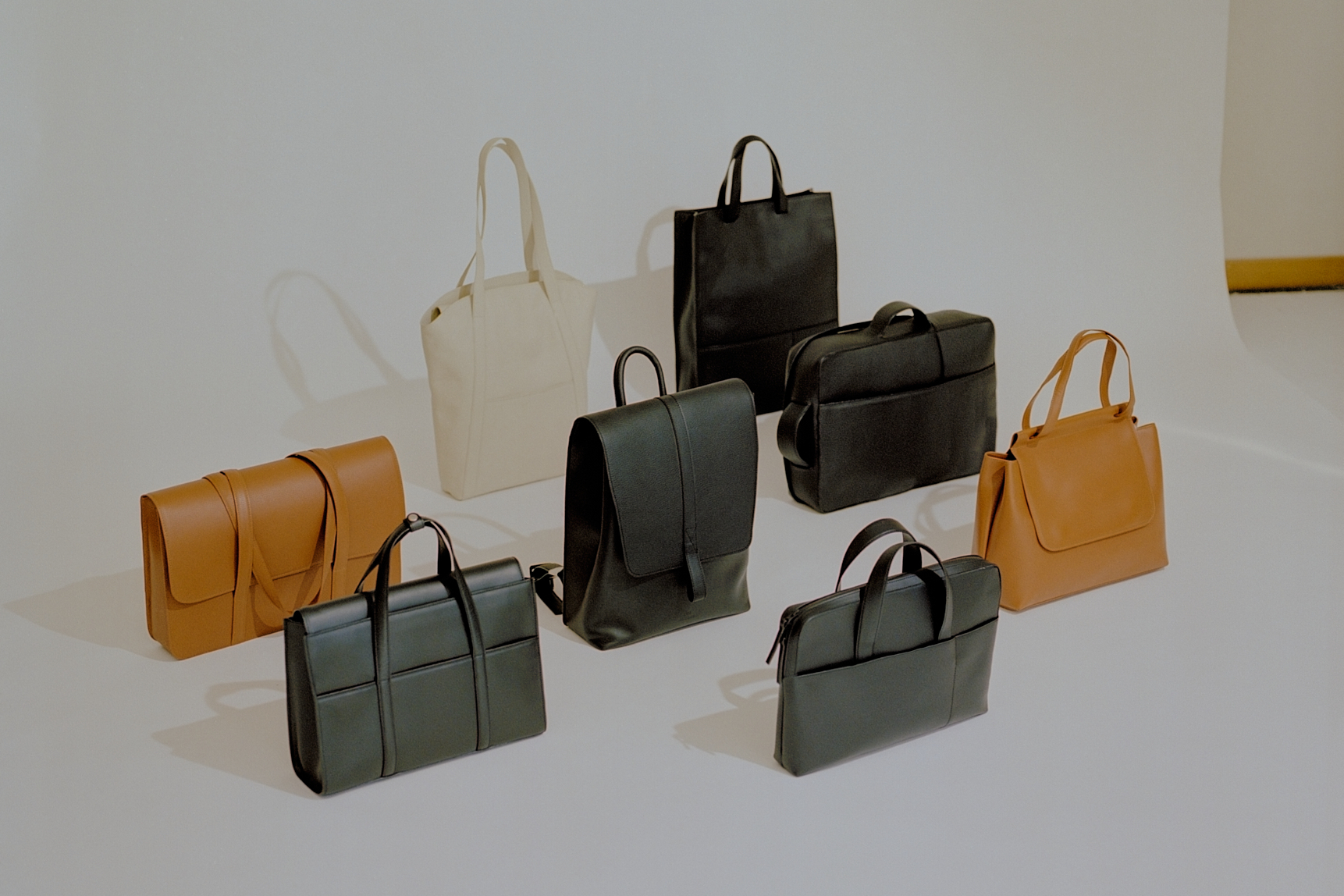Lies Mertens
Who is… Lies Mertens?
Lies Mertens has been designing leather handbags, backpacks and wallets under her own name since 2017.
Her items breathe timeless luxury and refinement, yet they are very practical too. Thanks to separate compartments for storing laptops and smartphones, Lies Mertens’ bags make life easier, as well as helping women express their style and personality.
Creativity meets functionality: this special combination also typifies Lies Mertens herself, who studied both graphic design and management.

![]()
Resources
LWG certified leather from a circular tannery
Lies Mertens is all about leather, selecting the material with great care. The brand works with German and Italian calf leather that is tanned in a circular tannery with its own wastewater treatment system and renewable energy production. Though the tanning process is governed by European legislation, Lies Mertens takes the extra step of limiting herself to leather that is awarded silver or gold certification by the Leathering Working Group (LWG). This non-profit has been setting best practices for the leather industry since 2005 and it has its own audit protocols, ensuring Lies Mertens that her products are crafted from leather with a minimal environmental impact, regardless of the tanning process (chrome or vegetable).
![]()
Design
Timeless designs with little hardware
During the design process, this Belgian brand tries to steer clear of zippers, buttons and buckles. Because this kind of hardware tends to wear out or break relatively quickly, Lies Mertens prefers more sustainable alternatives. Moreover, the label comes up with new models, colours and collabs in its own sweet time, so the creative process doesn’t get trapped in the straitjacket of two fixed launch moments per year. This guarantees a more even spread of both expenses and cashflow. Moreover, it takes the pressure off the design process and allows the brand to respond more adequately to supply and demand. It goes without saying that the result is not a seasonal but rather a timeless collection, with items that last for years – both quality and looks wise.
![]()
Production
Portuguese, limited-edition production, with accessories from leftover leather
Every Lies Mertens product is made by hand in a small Portuguese family business that has been around for many years and knows all about leather. The bags are produced in limited edition, which means that Lies Mertens can react swiftly to customer needs, avoid overstock, and implement design improvements whenever necessary. Take the CMMC, for instance. This bestseller will soon receive an update in the form of small adjustments to the lining, the strap and the fasteners. Though the new CMMC bag will look the same as the old one, it will actually become a better version of itself.
And have you ever wondered why Lies Mertens wallets don’t have a fixed colour palette and are sometimes released in editions as limited as three? Well, that’s because they are made from leftover leather. Mertens will soon be launching even more small accessories, like keychains, to get the absolute most out of her material.
![]()
Retail
Zero-stock policy and stock sale for imperfect items
Lies Mertens handbags can be scored in the flagship store in Antwerp and around thirty other points of sale all over Belgium. The brand encourages customers to stop by their store to try out a few bags before deciding, and to shop consciously rather than to buy on impulse. Customers who purchase an item because they just can’t get it out of their heads: that’s what the brand loves most of all.
Lies Mertens tries to work on a zero-stock policy: the idea is to sell out completely at the end of the ride. Even bags of lesser quality or with small defaults find a new owner (for a lower price) thanks to the traditional November stock sale. This event gives customers who are on a budget a chance to go home with a Lies Mertens, too.
Because the label doesn’t follow the fashion calendar, it has skipped the twice-yearly sale periods so far. Yet, as an emerging brand, Lies Mertens could use the extra cashflow in the now relatively quiet months of January and June. Though the brand will never be caught slashing prices, it does consider taking part in a sale period in the future, with a few items that can go from the collection.
![]()
Consumption
Repair service (and design lessons learned)
It’s no surprise to see a lot of Lies Mertens bags in the streets. After all, the brand makes products that are not just lovely to look at, but that beg to be used. Lies Mertens wants customers to enjoy their items for a long time, helping them with tips on how to polish, clean and store their bag. Customers can even return their bags for a ‘wellness session’. The team fixes them free of charge – unless of course the damage is clearly caused by the owner’s negligence. Thanks to this service, the brand can find out which parts are prone to wear and tear. It collaborates closely with the manufacturer to avoid these flaws in the future.
![]()
End of life
Looking into the possibility of a take-back system
Though the brand realises it would be very interesting to get customers’ old bags back, to see where they need some extra TLC and to improve the designs accordingly, there are no plans for a take-back system as of yet. However, Lies Mertens wants to look into the possibility of setting up such a system, and become more sustainable in this respect too.

Which lesson(s) do you want to share?
Mertens: “We have learned that the most sustainably produced item is not necessarily the most sustainable in terms of lifespan. The organic leather that we used for our first collections, for instance, does not age as we had anticipated, so people are swapping their bags for new ones much quicker. That’s obviously not what we had in mind, so we are currently experimenting with several materials, comparing relevant aspects such as lifespan, quality, sustainable production and the way they age. In other words, sustainability means focusing on many things: not just sourcing the right materials, but also keeping an eye on the working conditions, production locations and product lifetime.”
This page was created in March 2021. Curious to find out where Lies Mertens stands now? Feel free to get in touch with hello@liesmertens.be!
Lies Mertens (designer and founder Lies Mertens)
What does sustainability mean for you?
Lies Mertens: “To us, sustainability means creating a product that lasts for years, and doing it in an ecologically responsible and sustainable way. We want to come up with high-quality, timeless designs that people can use for a long time. When I sat down to draw up my business plan three years ago, it was only natural for me to question every piece of the puzzle. Actually, this should be self-evident for every entrepreneur.”
“Leather is not often considered an ecological choice, yet in certain circumstances – as a byproduct from the meat industry and when sustainably produced – that’s exactly what it is. A sustainable future for the production of leather (alternatives) will happen via different routes. As long as we keep consuming meat and dairy, animal leather will be a part of our lives, and the hides can be used sustainably. What matters then is to continually improve the tanning processes, so that they require less energy, chemicals, water and resources, while still resulting in durable and sturdy leather items. Simultaneously, products that resemble animal leather, such as grape leather or lab-grown leather, will develop into worthy alternatives too. By pursuing these different ways, we can keep on designing sustainable products that make our lives easier and more beautiful.”
What challenges are you currently facing?
Mertens: “We want to be a sustainable and timeless brand that doesn’t follow trends and that will be around for a long while. That’s why we keep raising the quality bar for our bags. It’s not always easy, though. As a small team, we have to rely heavily on third parties such as our tannery and manufacturer. And the loop hasn’t been closed yet: we are not yet operating in a circular way. We would like to complement our repair service with a system to give a second life to old bags or to have them recycled. We could mill the leather to scraps to make Salpa, for instance, which is perfect for reinforcing new leather products.”